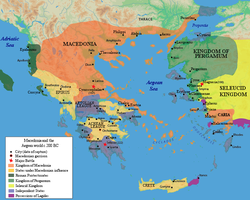Aetolian League
League of the Aetolians Koinon tōn Aitōlōn | |||||||||
|---|---|---|---|---|---|---|---|---|---|
| 4th century BC–188 BC | |||||||||
Roman–Seleucid War | 188 BC | ||||||||
| |||||||||
| Today part of | Greece | ||||||||
The Aetolian (or Aitolian) League (
During the
History


The Aetolians were a recognised ethnic group with a religious centre at Thermos from at least the seventh century BC. During the
After the death of Philip II in 336 BC, the Aetolians joined the Thebans in opposing Alexander the Great and the stress of their defeat caused the league to implode. Over the next decade it seems to have been reconstituted and in the later years of Alexander's reign the Aetolians seized Oeniadae against his will.
The Aetolian League joined the Athenians in the

In 279 BC, they were victorious in battle against the
In 232 BC, the Illyrians under Agron attacked the Aetolians, and managed to take many prisoners and booty.[10]
In 229 BC, the Aetolians participated in a naval battle off the island of Paxos in a coalition with Korkyra and the Achaean League, and were defeated by a coalition of Illyrians and Acarnanians; as a result, the Korkyreans were forced to accept an Illyrian garrison in their city, which was put under the command of Demetrius of Pharos.[11]
In the
The league was the first Greek ally of the
Administrative system

The league had a federal structure, which could raise armies and conduct foreign policy on a common basis. It also implemented economic standardization, levying taxes, using a common currency and adopting a uniform system of weights and measures. There may not have been any central archive of state documents. However, the constituent communities of the league enjoyed substantial autonomy. At times the league was unable (or unwilling) to prevent its members from undertaking military actions against states that had treaties with it. The league members were grouped together in a number of tele (districts), which seem to have had administrative and juridical powers of some sort.[12]
The league's central administrative apparatus consisted of an assembly, a council, and a number of magistrates. The
The exact competencies of the Council, referred to as a boula or synedrion in different documents, relative to the Assembly are not clear. It consisted of delegates elected by each of the constituent communities of the league in proportion to their size. By the late third century BC it had around 1500 members - too large for it to have been in continuous session. A small portion of the council's members, known as the apokletoi ("Select-men"), conducted day-to-day business, such as sending and receiving embassies.[13]
The league's
From 278 the league sent delegates to the
Piracy
The Aetolian League acquired a reputation for
By contrast, Grainger concludes that Aetolian involvement in piracy appears unlikely given that they lacked the necessary ships.[17]
References
- ^ "Αἰτωλός - Ancient Greek (LSJ) 👍". lsj.gr. Retrieved 2020-07-28.
- ^ Grainger, 1999
- ^ Hogan, 2008
- ^ West, 1902
- ^ Thucydides 3.94
- ^ "ΟΜΗΡΙΚΗ ΕΡΕΥΝΑ: Οι Αιτωλοί από τον Όμηρο μέχρι την ύστερη αρχαιότητα".
- ^ N. Tod, A selection of Greek Historical Inscriptions, vol. 2, p. 137
- ^ John D. Grainger, The League of the Aetolians, p. 49
- ISBN 0520201876.
- ^ Polybius 2.3
- ^ Polybius, 2.10; Wilkes, p. 160.
- ISBN 0520201876.
- ^ ISBN 0520201876.
- ISBN 0520201876.
- ^ Walbank, CAH (2) VII 1, 232 and 255
- ^ CAH (2) VII 1, 107
- ^ John D. Grainger, The League of the Aetolians, chap. 2
Sources
- John D. Grainger (1999) The League of the Aitolians (Google Books).
- C. Michael Hogan, Cydonia, Modern Antiquarian, January 23, 2008 [1]
- Krzysztof Kęciek (2002) "Kynoskefalaj 197 p.n.e" Serie Historic Battles Published in Warsaw by Bellona.
- Joseph B. Scholten (2000) The Politics of Plunder: Aitolians and Their Koinon in the Early Hellenistic Era (Google Books).
- Willis Mason West (1902) Ancient History to the Death of Charlemagne, Allyn and Bacon.
External links
 Media related to Aetolian League at Wikimedia Commons
Media related to Aetolian League at Wikimedia Commons
